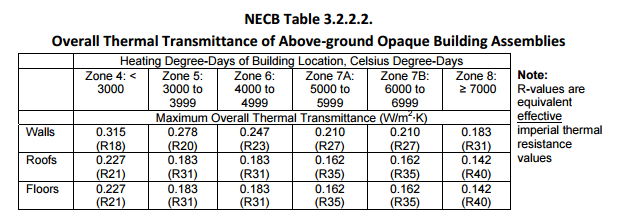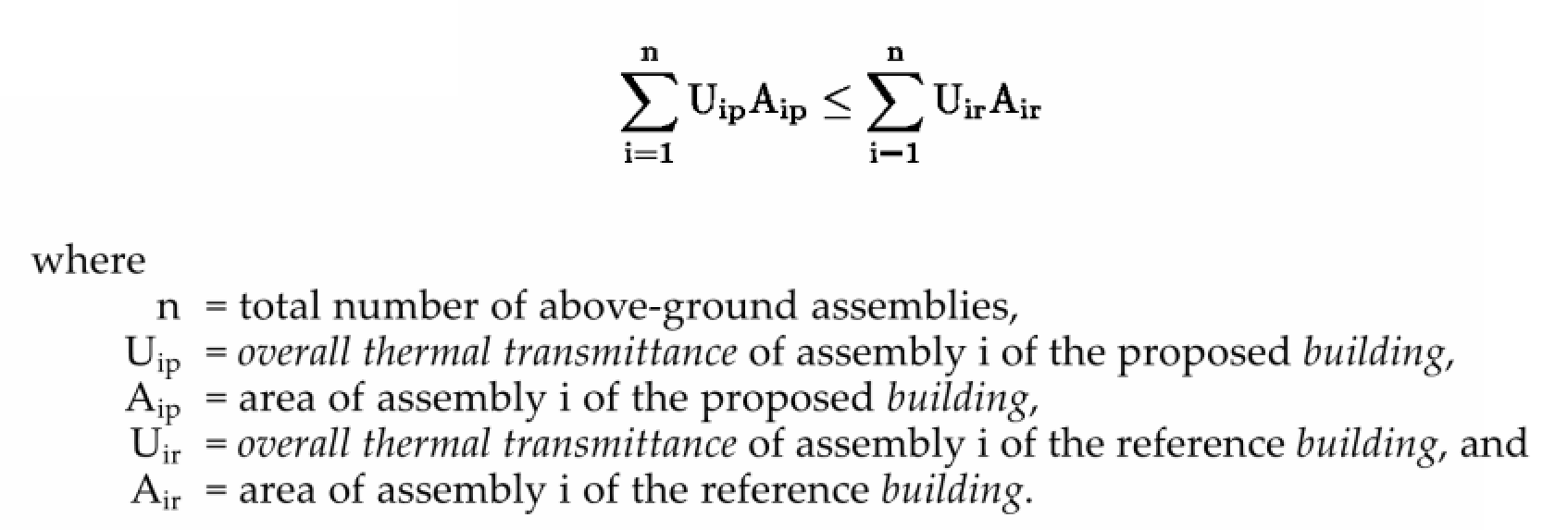
As many of us in the building industry already know, Alberta has adopted the National Energy Code for Buildings (NECB) 2011 edition into its newest Building Code. The coming into force date for the new energy code is November 1, 2015 and it will have profound effects on how buildings are constructed in Alberta. While most people are aware of the changes, a lot of us still don't realize the full impacts that the new building code will have on our building designs. This post will attempt to shed a little light on the new building code as well as provide some useful tips and advice.
First off, let's quickly describe what the new building code is. NECB 2011 is an energy code that is designed to increase energy efficiency in buildings. The new energy code provides an improvement of about 25% over the previous version of the code (MNECB 1997)--which alongside ASHRAE 90.1-2007 is widely used for LEED compliance. A building built to NECB 2011 will provide a similar level of performance to one built to ASHRAE 90.1-2010. The code has specific sections and requirements pertaining to the envelope, lighting, HVAC, service water heating and electrical power systems but the code does not address things like durability, energy source, renewable energy generation or operations. NECB 2011 is applicable to the following types of buildings:
Note: NECB 2011 is not applicable to farm buildings and renovations (mostly).
Now that we know what the building code is and what types of buildings it applies to, let's look at how we can achieve compliance. There are three paths available to achieve compliance and they are as follows:
In order to determine which path is best for your project, let's go over the options in a little more detail:
Section 3.2: Prescriptive Path
The prescriptive path is definitely the easiest path to understand and requires the least amount of expertise, but also offers the least amount of flexibility. The prescriptive requirements (for all sections) must be followed exactly and might prove challenging to meet. For example, in the envelope section, the maximum allowable fenestration and door area (for Edmonton) must be determined according to the following formula (where FDWR is the fenestration and door area to gross wall ratio): FDWR = (2000 - 0.2*HDD) / 3000. This means that in Edmonton, the maximum allowable FDWR = 0.32 (or 32%). In the prescriptive path, you cannot go above this number and achieve compliance. Similarly, the energy code provides prescriptive requirements for envelope thermal transmittance values which must be matched to achieve compliance, as seen in the chart below (Edmonton falls under Zone 7A):

Any keen observer will notice that the required thermal resistance values are about double that of what is typically constructed in Alberta at the moment. Some existing wall assemblies (like curtain-wall or z-girt systems) are not likely to meet the prescriptive requirements of the new code. Also, the required values are effective thermal transmittance values, meaning that to demonstrate compliance, the architect will need to perform calculations to determine the effective R-value of the envelope. We can see that perhaps the prescriptive path isn't so easy after all. Is there a way to avoid these requirements, or at least have more flexibility? Luckily, yes. So let's move on to the next compliance path.
Section 3.3: Trade-Off Paths
Section 3.3.3: Simple Trade-off Path
The simple trade-off path only applies to the maximum overall thermal transmittance and the allowable fenestration and door areas. In essence, this trade-off path allows you to deviate from the maximum allowable overal thermal transmittance and/or the allowable fenestrations and door areas if you demonstrate that the proposed changes are at least as good as the prescriptive requirements. The calculations used for this path is as follows:

For example, you can exceed the maximum allowable FDWR ratio if your windows have a performance value that is greater than the requirement in the code and the sum of U x A is the same value. Obviously this still does not give us a lot of flexibility, so let's look at the detailed trade-off path.
Section 3.3.4: Detailed Trade-off Path
The detailed trade-off path is more complicated and requires additional calculations but allows for additional flexibility in the design. It should be noted however that the detailed trade-off path can only be used within each building section (envelope, hvac, lighting etc...); one cannot trade efficiencies in the hvac system for envelope reductions for instance. As an example of the process for a detailed trade-off in the envelope section, this path requires you to calculate the yearly energy consumption of the building envelope for both the proposed and reference building envelopes (where the reference building envelope is one that follows the prescriptive requirements of the code). This method ignores the occupant density, interior lighting, plug loads, HVAC energy, schedules and other non-envelope systems in the energy calculation. All building components and areas are the same, but the FDWR ratio and thermal resistance values in the reference building must be as per the prescriptive requirements. If you can demonstrate that the proposed building envelope uses the same or less energy than the reference buildng envelope, compliance is demonstrated.
Parts 4, 5, 6 and 7: Additional Trade-off Paths
It should be noted that Parts 4 (lighting), 5 (HVAC), 6 (Service Water Heating), and 7 (Electrical Power Systems) also have trade-off paths that can be pursued within each section. Because of the complexity of these sections, we will not discuss the trade-off paths in this article. However, there are tools available for dealing with the trade-offs in each section, please contact us to learn more.
Part 8: Building Energy Performance Compliance Path
The building energy performance path is definitely the compliance path that requires the most expertise (as it requires building energy modelling) but is also the most flexible and will likely be the path chosen by most design teams. For most projects this is the compliance path that we would recommend as it will very likely be the most cost effective compliance path (in terms of building cost). The reason for this is quite simple actually. When comparing the proposed building to the reference building, NECB 2011 uses energy savings as a metric; unlike LEED which uses energy cost. What this means is that any efficiencies (over the reference building) in the lighting, HVAC and service water heating sections can be used to offset the requirements of the envelope section.
For example: NECB 2011 requires a 50% efficient heat recovery system if the sensible heat content of an exhaust air system is greater than 150 kW. This works out to be any system with an air flow rate above approximately 2360 L/s (5000 cfm). If the proposed building has an air system below this value, but still includes a heat recovery system (which we would always recommend), the comparison between the proposed and reference energy use is huge. Even if the proposed system is greater than 2360 L/s, a typical heat recovery system is at least 70-75% efficient (up to 90% with the right equipment), so the difference between the two systems (25-40% efficiency) is still significant. This energy savings can be used to scale back the requirements of the building envelope, so instead of R27 effective, you might get away with R22 or so (ideally, we would probably prefer not to scale back the envelope and get the energy savings, but we realize that cost is always an issue).
Another example would be the use of a geothermal heating and cooling system. Geothermal systems typically use 70% less energy than a traditional system (and thus the reference building) so this energy savings can be used to reduce the envelope requirements, increase glass percentage, increase lighting etc... Using efficient systems gives the designers complete freedom to innovate and be more flexible in their building design. For some buildings, having a FDWR ratio of 0.32 is not practical or desired, and for larger cooling dominant buildings, an R-value of R27 might actually increase our energy use because the added envelope traps internal heat gains and thus requires increased cooling (something we came across during the design of the Mosaic Centre). Essentially, this compliance path allows you the designer the choice of where to make the efficiency improvements, instead of having to follow the stringent prescriptive requirements.
Conclusion
While the new energy code might seem scary at first, it really doesn't have to be. If you know how the code is set up and where to find efficiencies, reaching compliance can be relatively easy. Our recommendation would be to follow the Building Energy Compliance Path as it allows the most flexibility in the building design and allows you to take advantage of efficiencies from other systems to offset envelope requirements. Because of the nature of the compliance path, energy modelling is a requirement for projects wishing to go this route. However, if the building is already going after LEED or other rating system compliance, the energy model used for the rating system compliance can be adapted and used for NECB 2011 compliance with relative ease; thus not requiring a brand new model. Either way, energy modelling is the best way to guide a project to success, and this is even more true now considering the implementation of the new energy code. Energy modelling from an early design stage is the best way to provide a cost-effective design under NECB 2011 and gives the design team much more flexibility in all aspects of the building design.
We hope this post has shed some light on how the new energy code works. Please feel free to contact us if you have any questions or need assistance on a project. Our extensive experience in green building consulting, hvac system design as well as energy modelling can help guide teams to the most cost-effective solutions for meeting the new energy code. The Building Energy Compliance Path is definitely the preferred method of compliance for most projects but requires a thorough understanding of how each building component affects the other, we believe this is where we are at our best.
Revolve Engineering can provide the following services to help your team achieve NECB 2011 Compliance:
For more information on NECB 2011, or to buy a copy, please visit NRCan's website